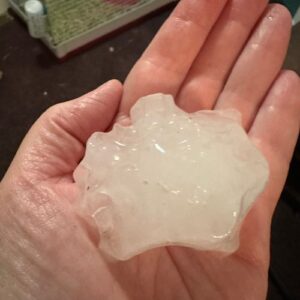Was Your Roof Damaged by Hail? Use This Hail Size Chart to Find Out
Hailstorms can be tough on your roof—but not every hailstone causes damage. So, how do you know if it’s time to call a roofer?
One way to start is by checking the size of the hail that hit your home. Weather reports often compare hailstones to common objects like quarters or golf balls. Our hail size chart below helps match those sizes with the type of roof damage they’re likely to cause.
At Anchor Roofing, we’ve handled roof inspections after dozens of hailstorms across Omaha, NE. We know firsthand that even small hail can cause problems, especially on older roofs. In this guide, we’ll break down common hail sizes, explain what damage to look for, and help you decide whether it’s worth filing an insurance claim after a storm.
Use our hail size chart to help decide if your roof needs a closer inspection.
How Is Hail Size Expressed?
Following a hailstorm, or even during the storm event, you’re likely to see weather reports that describe the size of the hail. Typically, this is done by comparing the hail to some everyday object, such as a golf ball or a quarter.
While of course, hail can be (and is) measured in terms of numerical size, the reason most meteorological outlets describe hail size this way is to provide viewers or readers with an immediate and concrete comparison, compared to a specific size like 1 3/4 inches.


What Size Hail Causes Damage?
The exact point at which hail becomes damaging can vary (for reasons we’ll explain shortly). However, as a general rule, hail is considered “large” and can become damaging at 1 inch in diameter (quarter-sized), and it is very likely to be damaging at around 1 3/4 inches (golf ball-sized).
Of course, this also depends on your roof. If your roof is aging or made from less impact-resistant materials, damage will occur more easily. Meanwhile, roofs made from impact-resistant shingles or materials like metal and tile may resist damage even from larger hail.
Hail Size Chart: Dimensions and Likely Effects
Below, we’ve put together a hail size chart detailing the comparisons you’re likely to read in news and weather reports. We’ve also included some details on the potential effects of each size of hail.
| Hail Size | Approx. Diameter | Potential Roof Damage |
|---|---|---|
| Pea | 1/4 inch | Damage unlikely; may cause small dings or cosmetic scuffs |
| Mothball / Marble | 1/2 inch | Surface-level shingle damage or granule dislodgement possible |
| Penny | 3/4 inch | May damage older/low-quality roofs; can dent soft metals |
| Nickel | 7/8 inch | Can cause granule loss or damage to older roofing systems |
| Quarter | 1 inch | Can crack shingles, dent metal roofs, and affect underlayment |
| Half Dollar | 1 1/4 inch | Likely to crack shingles, dent vents/flashing; damage to older/low-quality roofs expected |
| Ping-Pong Ball | 1 1/2 inch | Cracks/tears shingles, deforms metal roofing; granule loss very likely |
| Golf Ball | 1 3/4 inches | Severe hail damage likely; significant impact expected |
| Tennis Ball | 2 1/2 inches | Damages even Class IV shingles; widespread damage to standard roofs |
| Baseball | 2 3/4 inches | Likely requires widespread roof replacement, even for impact-resistant roofs |
| Large Apple | 3 inches | Extreme damage to all roofs in the affected area |
| Softball | 4 inches | Catastrophic damage to roofs and surrounding properties |
| Grapefruit | 4 1/2 inches | Catastrophic damage to all roofs and properties |
Are There Important Factors Other Than Size?
Absolutely. In fact, hail density is just as important as hail size. This is because a denser piece of hail will weigh significantly more, which enables it to be more destructive. In some cases, a smaller hailstone can be more destructive than a larger one due to its greater density.
Unfortunately, density is more difficult to measure or express compared to size. While anyone can easily pick up a hailstone and measure it with a ruler—or even visually assess it—it’s harder to accurately measure the density. Some damage can even void your roof warranty if left untreated. This is why an inspection after a storm is critical.
In other words, while hail size does not provide a complete picture of the destructive potential of hail, it generally works as a rule of thumb.
Unsure About Damage? Call Anchor Roofing Today!
While weather reports and a hail size chart can help predict whether your roof was damaged by hail, in many cases, the only way to know for sure is to get in touch with a local roofing company. At Anchor Roofing, we’re renowned as storm damage experts here in Omaha.
If your property was in the path of recent hailstorms, reach out to our team to book an inspection and assess potential damage to your home.
